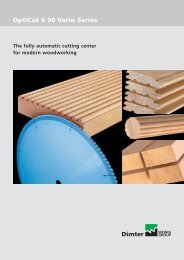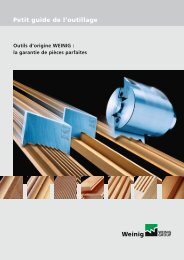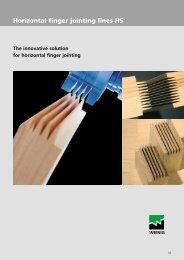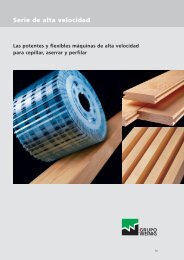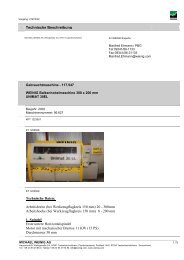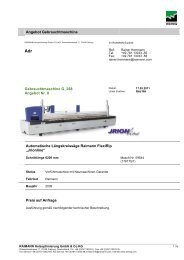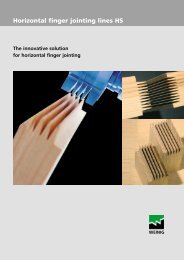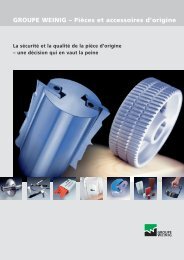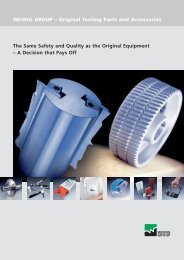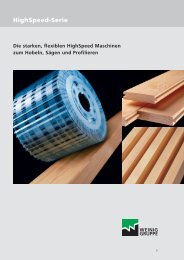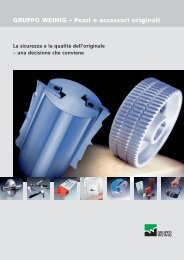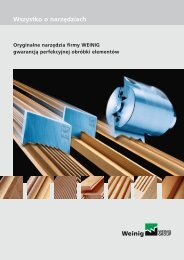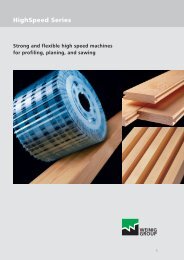Weinig PDF all about tools
Weinig PDF all about tools
Weinig PDF all about tools
Create successful ePaper yourself
Turn your PDF publications into a flip-book with our unique Google optimized e-Paper software.
All <strong>about</strong> Tools<br />
Original WEINIG Tools<br />
Your Guaranty for Super Workpieces
The cutterhead defines the workpiece quality.<br />
The best machine only works as well as<br />
the tool it is equipped with. A high<br />
quality WEINIG moulder in combination<br />
with a precision tool produce top<br />
quality and performance. WEINIG offers<br />
you <strong>all</strong> the <strong>tools</strong> that are used for<br />
planing and profiling:<br />
• PowerLock <strong>tools</strong><br />
• Hydro clamping<br />
• Conventional <strong>tools</strong>.<br />
The Rondamat Series is our knife<br />
grinder for extreme precision in knife<br />
production. With it you are able to<br />
manufacture and regrind profile and<br />
planer knives for any desired profile.<br />
Fast, exact and reasonably priced.<br />
Tool measuring and display systems<br />
complete our tool grinding systems.<br />
This complete solution guarantees you<br />
the highest profile precision and at the<br />
same time enormous savings in set-up<br />
time.<br />
As the worldwide leader in moulders<br />
and tooling for moulders, we know<br />
what we are talking <strong>about</strong>. The WEINIG<br />
GROUP supplies you with the optimal<br />
tool for every type of machine.<br />
In this brochure you will find valuable<br />
information <strong>about</strong> tooling that<br />
will enable you to be more profitable<br />
and responsive to the market.
2 3<br />
Contents<br />
Introduction . . . . . . . . . . . . . . . . . . . . . . . . . . . . . . . . . . . . . . . . . . . . . . . page 2<br />
Most important distinguishing features<br />
Original WEINIG cutter heads and knives page . . . . . . . . . . . . . . . . . . . page 4<br />
Flexibility, independence and customer satisfaction<br />
Preparing <strong>tools</strong>: The WEINIG grinding system . . . . . . . . . . . . . . . . . . . . . page 6<br />
Surface quality<br />
Knife marks and surface quality . . . . . . . . . . . . . . . . . . . . . . . . . . . . . . . page 8<br />
Tool technology<br />
Conventional tool technology . . . . . . . . . . . . . . . . . . . . . . . . . . . . . . . . page 10<br />
Hydro tool technology . . . . . . . . . . . . . . . . . . . . . . . . . . . . . . . . . . . . . . page 12<br />
PowerLock tool technology . . . . . . . . . . . . . . . . . . . . . . . . . . . . . . . . . . page 14<br />
Performance optimization<br />
Solutions for increasing performance . . . . . . . . . . . . . . . . . . . . . . . . . . . page 16<br />
WEINIG Technology . . . . . . . . . . . . . . . . . . . . . . . . . . . . . . . . . . . . . . . . page 17<br />
It’s the tool that makes the difference<br />
Basics of moulding and planing . . . . . . . . . . . . . . . . . . . . . . . . . . . . . . . page 19<br />
Knife materials . . . . . . . . . . . . . . . . . . . . . . . . . . . . . . . . . . . . . . . . . . . page 20<br />
All <strong>about</strong> planer knives and knife blanks . . . . . . . . . . . . . . . . . . . . . . . . page 21<br />
WEINIG as complete supplier<br />
Knife systems . . . . . . . . . . . . . . . . . . . . . . . . . . . . . . . . . . . . . . . . . . . . page 22<br />
The right accessories . . . . . . . . . . . . . . . . . . . . . . . . . . . . . . . . . . . . . . . page 23<br />
Safety comes first<br />
Certification and safety regulations . . . . . . . . . . . . . . . . . . . . . . . . . . . . page 24<br />
The WEINIG GROUP . . . . . . . . . . . . . . . . . . . . . . . . . . . . . . . . . . . . . . . . . . page 26<br />
Titelmotiv:<br />
Seite 2:<br />
WEINIG Cutterheads – flexble and true to profile<br />
Original WEINIG Cutterheads with replaceable knives
WEINIG cutterheads<br />
Depending on your production requirements<br />
knives can be easily and quickly<br />
exchanged. With the very same cutterhead<br />
you can produce a multitude of<br />
profile shapes or planed surfaces.
4 5<br />
The Original WEINIG Cutterheads:<br />
Extremely Flexible and Absolutely True to Profile<br />
Corrugated Knife <strong>tools</strong> are assembled<br />
<strong>tools</strong> consisting of a cutter head and<br />
removable knives. With the same cutterhead<br />
you can produce a multitude of<br />
profile shapes or use straight knives for<br />
planing by simply changing the profile<br />
knives with knives that have a different<br />
profile. For different wood species or<br />
substrates you can select the most suitable<br />
knife material.<br />
Mill-to-Pattern <strong>tools</strong>, on the other<br />
hand, are compound <strong>tools</strong>, i.e. cutting<br />
edges and supporting body are permanently<br />
bonded. This results in the following<br />
disadvantages:<br />
The individual tool can only be used for<br />
one profile and must also be exchanged<br />
when the material being processed<br />
require different knife materials. If the<br />
knives have been worn out by regrinding,<br />
the entire tool must be replaced or<br />
refurbished.<br />
The use of corrugated knives is more efficient and <strong>all</strong>ows the user<br />
to react quickly to customer demands. WEINIG manufactures only<br />
cutter heads that utilize removable knives.<br />
Corrugated knives are profiled and<br />
reground in the back of the knife<br />
according to a profile template. Thus<br />
absolute profile accuracy and optimal<br />
cutting angles are assured – for a tool<br />
accurately ground and smooth running!<br />
Mill-to-Pattern <strong>tools</strong> are ground on<br />
the face. Individu<strong>all</strong>y or as cutter sets.<br />
They are used for special production,<br />
such as dowels, grooves and finger<br />
jointing <strong>tools</strong>. Because of the clearance<br />
angle on the back of the knife, the<br />
profile could change with every<br />
regrinding of the knife face. Profile<br />
accuracy is not guaranteed.
6 7<br />
WEINIG Tool Grinding Systems:<br />
More Flexibility and Independence<br />
WEINIG’s Rondamat-Series is a toolgrinding<br />
machine program geared<br />
to individual requirements and conditions.<br />
It offers extraordinary precision<br />
– for processing hardwood or<br />
softwood, MDF or plastic material.<br />
Wood pattern<br />
Profile drawing<br />
With original WEINIG cutterheads you<br />
are flexible and independent, because<br />
now you can produce your profile<br />
knives yourself. Fast, without any problems,<br />
at reasonable prices and without<br />
any long delivery times. This applies to<br />
every order, every batch size and every<br />
profile, however individual it may be.<br />
Profile template<br />
Knife blank<br />
With a few easy steps you can produce<br />
a tool within a short period of time.<br />
According to a drawing or an existing<br />
profile you produce a profile template<br />
in the scale 1:1. According to this you<br />
profile the knife blank in a few minutes<br />
with the Rondamat profile grinder.<br />
HSS, as well as stellite or carbide knives<br />
can be profiled or sharpened with the<br />
correct grinding wheels.<br />
Cutterhead
Which knife mark length is the right<br />
one depends upon the desired surface<br />
quality. Particularly smooth surfaces<br />
such as for furniture production<br />
require a sm<strong>all</strong> spacing between knife<br />
marks. For construction timber a longer<br />
spacing between knife marks can be<br />
accepted. Experience shows that good<br />
surfaces are achieved with knife mark<br />
spacing of approx. 1.5 – 1,7 mm.
8 9<br />
Knife Marks Matter:<br />
Knife Marks and Surface Quality<br />
fz<br />
The knife mark<br />
When planing with a rotating tool a<br />
knife mark, shaped like a wave, is<br />
created on the planed or profiled surface.<br />
The length of the knife marks<br />
corresponds to the distance between<br />
the entry and the exit of the individual<br />
knife blades. This distance is c<strong>all</strong>ed the<br />
knife mark spacing.<br />
v =<br />
n =<br />
z =<br />
The longer a knife mark, the more<br />
clearly the waves become visible on the<br />
planed surface.<br />
The shorter a knife mark, the smoother<br />
and finer the surface of the workpiece<br />
will be.<br />
The length of the knife mark f z depends<br />
on the feed speed v, the rpm n of the<br />
spindles and the number of knives z in<br />
the tool unit.<br />
The distance between knife marks can<br />
be calculated according to the following<br />
formula:<br />
f z =<br />
v x 1000<br />
n x z<br />
Diagram 3 shows clearly how the<br />
surface quality increases with reduced<br />
knife mark spacing.<br />
Proportion<strong>all</strong>y the wear on the knife tip<br />
increases reducing the running time.<br />
1<br />
mm<br />
1.5<br />
mm<br />
Surface quality increases<br />
Total tool path decreases<br />
2 mm<br />
Surface quality decreases<br />
Total tool path increases
Length of the knife mark fz<br />
Feed speed v<br />
Rpm of the spindles n<br />
Number of knives in the tool unit z<br />
Example 1 with<br />
conventional tool:<br />
f z =<br />
v x 1000<br />
n x z<br />
12 x 1000<br />
6000 x 4 1 = 2mm<br />
Example 2 with<br />
conventional tool:<br />
f z =<br />
8 x 1000<br />
6000 x 4 1<br />
v x 1000<br />
n x z<br />
=1.3mm
10 11<br />
WEINIG Cutterhead Technology:<br />
Conventional, Hydro or PowerLock<br />
We offer for every desired surface quality and feed speed the suitable<br />
WEINIG cutter head: a tool with conventional clamping, a tool<br />
with classic hydro-clamping or a modern PowerLock tool. With this<br />
variety we can comply with your requests and requirements.<br />
Tools with<br />
conventional clamping<br />
They are fastened with a spindle nut on<br />
the front of the spindle. Because of this<br />
limits are set on the surface quality and<br />
the feed speed. The reason: In order to<br />
fasten the cutter head, a fit tolerance<br />
of up to 0.05 mm is required. This<br />
causes a slight movement of the cutter<br />
head on the spindle. The result:<br />
Although <strong>all</strong> the cutting edges are in<br />
use, only the one projecting farthest<br />
determines the surface finish.<br />
Therefore only a 1 may be used for z<br />
v x 1000<br />
into the formula f z = .<br />
n x z<br />
Because of this “single-knife-finish”<br />
additional knives do not produce a<br />
shorter knife mark or an improvement<br />
of the surface. If however, the feed<br />
speed v, is reduced then the distance<br />
between knife marks is shortened.<br />
Good surface quality is only achieved<br />
with relatively low feed speeds<br />
(8–12 m/min).
12 13<br />
Original WEINIG Hydro Tools:<br />
High Surface Quality at High Speed<br />
The Hydro Tools from WEINIG provide for outstanding surface quality<br />
with top feed speeds in long run production. This tool system does<br />
not leave any room for clamping tolerances.<br />
Tools with hydro clamping<br />
They are not mechanic<strong>all</strong>y, but hydraulic<strong>all</strong>y<br />
clamped. Chambers built into the<br />
cutter head are filled with grease. With<br />
a high-pressure grease gun the pressure<br />
in these chambers is increased to 300<br />
bar. Because of this the w<strong>all</strong>s of the<br />
grease chambers expand and the cutter<br />
head is clamped absolutely with zero<br />
clearance and centered. On the spindle<br />
of the grinder exactly as on the<br />
machine. After relieving the pressure<br />
the clamping is released and the tool<br />
can be easily removed from the spindle.<br />
Thanks to the hydro clamping the<br />
accuracy achieved on the grinder can<br />
be fully and completely transferred to<br />
the moulder. After hydro clamping<br />
there is no fitting tolerance for this tool<br />
either.
Length of the knife mark fz<br />
Feed speed v<br />
Rpm of the spindles n<br />
Number of knives in the tool unit z<br />
Example with<br />
PowerLock tool:<br />
f z =<br />
20 x 1000<br />
12000 x 2 1<br />
v x 1000<br />
n x z<br />
=1.67mm
14 15<br />
The WEINIG PowerLock System:<br />
Flexibility, Performance, Quality and highest stability<br />
PowerLock tooling enables speeds up to 12,000 rpm meaning a<br />
doubling of the feed speeds in comparison to conventional<br />
machines. The <strong>tools</strong> are exchanged within seconds. With PowerLock<br />
you can double the linear meter capacity per day, significantly<br />
reduce the costs per unit of output and shorten delivery times – with<br />
an outstanding surface quality.<br />
Tools with<br />
PowerLock clamping<br />
They are not clamped convention<strong>all</strong>y,<br />
but with the PowerLock clamping<br />
system, free of play, centered and with<br />
highest stability – in the moulder and in<br />
the tool grinding machine. The clamping<br />
is released by pressing a button and<br />
the tool can be removed from the<br />
machine quickly and easily.<br />
Thanks to PowerLock clamping the<br />
accuracy and concentricity achieved on<br />
the grinder can be completely transferred<br />
to the moulder. There is no fit<br />
tolerance and therefore no movement<br />
of the tool!<br />
3 tons of clamping force form a solid<br />
unit between the PowerLock cutterhead<br />
and the tool holder. Result: the<br />
PowerLock-System has over double the<br />
stability of the Hydro-System. This<br />
advantage combined with 12,000 rpm<br />
ensures perfect surface quality at higher<br />
feed feeds.<br />
Feed (m/min)<br />
24<br />
16<br />
12<br />
6000 8000 12000<br />
Speed (rpm)
Only the Result Counts:<br />
Potential for Improved Performance<br />
Concentricity of the cutter head, feed speed per minute and the<br />
number of the knives in the cutter head determine the surface<br />
quality of the workpiece. The cutting circle of the individual knives<br />
must be exactly identical so that <strong>all</strong> the knives produce a finish cut.<br />
The WEINIG tool system offers the solution.<br />
Conventional tool: 0.05 mm<br />
The existing concentricity tolerance of<br />
the moulder spindle results in a difference<br />
of 0.05 mm in the cutting circle<br />
of the individual knives.<br />
Thanks to the concentric clamping of<br />
PowerLock and Hydro Tools the result is<br />
a deviation of only 0.003 – 0.005 mm<br />
in the cutting circle of the individual<br />
knives.<br />
But even this minimal tolerance<br />
does not mean that each knife<br />
produces the same length of cuttermark.<br />
Hydro Tool: 0.005mm<br />
PowerLock Tool: 0.003mm<br />
In order that <strong>all</strong> the knives in the cutter head have an absolutely<br />
uniform cutting circle, the tool must be jointed in the moulder.<br />
At operating speed, the knives are touched by a joint stone. This<br />
procedure removes <strong>all</strong> the remaining tolerances within the tool<br />
cutting circle. Now each knife produces precisely the same length of<br />
knife mark.
16 17<br />
Jointing Technology from the Expert:<br />
Top Quality with high feed speed<br />
In order to ensure high surface quality<br />
of the workpiece, the joint land at the<br />
knife tip may not exceed a certain<br />
width. For softwood it should not<br />
amount to more than 0.5 mm, for<br />
hardwood to more than 0.7 mm.<br />
For HSS or stellite knives, ceramic<br />
stones are used. For carbide knives,<br />
use special WEINIG jointing stones.<br />
Joint land<br />
Requirements for jointing<br />
… at the moulder:<br />
• heavy cast iron machine base<br />
• steady feed speed<br />
• high-performance spindles<br />
• optimal spindle speed<br />
• jointing equipment<br />
WEINIG Powermat and Hydromat<br />
moulders <strong>all</strong> have these requirements.<br />
… at the tool:<br />
• PowerLock or Hydro Tool<br />
• Precise straight or profile knife<br />
grinder (WEINIG Rondamat series)<br />
• Optim<strong>all</strong>y ground tool with ideal<br />
concentricity tolerance below<br />
0.01 mm<br />
• High back clearance angle on the<br />
knife<br />
Illustrations:<br />
Straight jointer with automatic joint<br />
stone feed<br />
Profile jointer with automatic joint<br />
stone feed.
At a glance:<br />
Knife mark spacing for jointed <strong>tools</strong><br />
V =<br />
V =<br />
V =<br />
V =<br />
800<br />
600<br />
400<br />
280<br />
4.67<br />
5.56<br />
3.89<br />
4.76<br />
3.33<br />
6.25<br />
4.17<br />
2.92<br />
5.56<br />
3.7<br />
2.59<br />
6.67<br />
5<br />
3.33<br />
2.33<br />
4.76<br />
3.57<br />
2.38<br />
1.67<br />
4.17<br />
3.13<br />
2.08<br />
1.46<br />
Distance between<br />
knife marks fz<br />
(mm)<br />
Feed speed v<br />
(m/min)<br />
Speed of the spindles n ( 1 /min)<br />
Number of knives in the tool unit z<br />
V =<br />
V =<br />
200<br />
180<br />
5<br />
4.17<br />
3.75<br />
3.33<br />
3<br />
2.78<br />
2.5<br />
2.38<br />
2.14<br />
2.08<br />
1.88<br />
1.85<br />
1.67<br />
1.67<br />
1.5<br />
1.19<br />
1.07<br />
1.04<br />
f z =<br />
v x 1000<br />
n x z<br />
V =<br />
160<br />
4.44<br />
3.33<br />
2.67<br />
2.22<br />
1.9<br />
1.67<br />
1.48<br />
1.33<br />
V =<br />
140<br />
3.89<br />
2.92<br />
2.33<br />
1.94<br />
1.67<br />
1.46<br />
1.3<br />
1.17<br />
V =<br />
V =<br />
120<br />
100<br />
5<br />
4.17<br />
3.33<br />
2.78<br />
2.5<br />
2.08<br />
2<br />
1.67<br />
1.67<br />
1.39<br />
1.43<br />
1.19<br />
1.25<br />
1.04<br />
1.11<br />
Table for Hydromat<br />
n = 6,000 rpm<br />
V =<br />
V =<br />
80<br />
60<br />
5<br />
3.33<br />
2.50<br />
2.22<br />
1.67<br />
1.67<br />
1.25<br />
1.33<br />
1<br />
1.1<br />
The knife is scraping, not cutting,<br />
high wear of the knives<br />
V =<br />
V =<br />
40<br />
20<br />
Z =<br />
3.33<br />
1.67<br />
2<br />
1.67<br />
4<br />
1.11<br />
6<br />
8<br />
10<br />
12<br />
14<br />
16<br />
18<br />
20<br />
28<br />
32<br />
High surface quality for tongue<br />
and groove boards, mouldings …<br />
Lower surface quality, planed<br />
timber, construction timber …<br />
V =<br />
100<br />
2.5<br />
1.67<br />
Table for Powermat 2000<br />
n = 10,000 rpm<br />
V =<br />
V =<br />
V =<br />
V =<br />
V =<br />
V =<br />
V =<br />
80<br />
70<br />
60<br />
50<br />
40<br />
30<br />
25<br />
4<br />
3.5<br />
3<br />
2.5<br />
2<br />
1.5<br />
1.25<br />
2<br />
1.75<br />
1.50<br />
1.25<br />
1<br />
1.33<br />
1.17<br />
1<br />
Powermat with feed speeds up to<br />
100 m/min.<br />
These are the PowerLock advantages:<br />
• low setting time<br />
• fewer knives in the tool<br />
• less grinding needed<br />
• higher productivity<br />
• and more profit<br />
V =<br />
20<br />
1<br />
Z =<br />
2<br />
4<br />
6
18 19<br />
Details that matter:<br />
Basics of planing and moulding<br />
For high surface quality it is important that <strong>all</strong> the factors of the<br />
tool contacting the wood are optimal. Usu<strong>all</strong>y machining is performed<br />
with the tool rotating against the feed direction. Certain composite<br />
materials (e.g. chipboards), or difficult species may require that the<br />
tool rotates in the feed direction.<br />
= cutting angle<br />
= wedge angle<br />
= clearance<br />
angle<br />
<br />
<br />
<br />
Cutting angle<br />
The cutting angle is integrated into the<br />
tool and cannot be changed. Tools with<br />
different cutting angles are available for<br />
various applications.<br />
Wedge angle<br />
With unjointed <strong>tools</strong> the wedge angle<br />
amounts to 50°, with jointed <strong>tools</strong> 40°.<br />
Wedge and clearance angle<br />
Both can be changed using a Rondamat<br />
knife grinder.<br />
Counter rotation<br />
The cutting motion of the tool and the<br />
direction of feed of the workpiece are<br />
in opposite directions. This proven<br />
procedure creates a long chip with<br />
increasing thickness.<br />
Advantage: By making a chip which<br />
breaks away before the knife exits the<br />
timber (pre-splitting), the cutting forces<br />
and power required to machine the<br />
material are reduced and longer total<br />
tool life achieved. Less machining<br />
power is needed.<br />
Disadvantage: Risk of tear-out in case<br />
of twisted or reverse grain in the workpiece.<br />
Synchronous rotation<br />
The cutting motion of the tool and the<br />
feed direction of the workpiece are in<br />
the same direction. This procedure,<br />
which is only used in special cases,<br />
produces a wood chip with decreasing<br />
thickness.<br />
Advantage: Even in case of twisted<br />
grain timber good surface quality free<br />
from tear-out is achieved.<br />
Disadvantage: Reduced tool life and<br />
higher motor power requirement because<br />
of the lack of the pre-splitting<br />
effect. In addition, safety devices are<br />
required at the out feed of the<br />
moulder.
Planer knives and profile blanks:<br />
The correct knife material is important<br />
The correct knife material will provide long service life and high<br />
quality surfaces. On this page we show you which materials are used<br />
in timber technology.<br />
High Speed Steel HSS<br />
HSS is an <strong>all</strong>oy steel including elements of carbon, tungsten, molybdenum, vanadium,<br />
cobalt and chromium. In wood processing it is the cutting material used most<br />
often.<br />
Ranges of application: softwood and most hardwoods.<br />
Total tool life with softwood 500 – 3000 running meters *<br />
Stellite<br />
Stellite is a material using cobalt with components of chromium, tungsten and iron.<br />
Stellite has a higher wear resistance than HSS and can be ground with normal<br />
corundum grinding wheels.<br />
Ranges of application: wet timber with long fibers; meranti, oak, poplar.<br />
Total tool life with softwood 500 – 1500 running meters *<br />
Carbide<br />
Carbide is a material with carbide particles embedded in a tough met<strong>all</strong>ic binder<br />
(cobalt and nickel). Different mixtures provide a wide spectrum of application.<br />
Ranges of application: hardwood, softwood and laminated wood; MDF as well as<br />
plastic material.<br />
Total tool life with hardwood 500 – 1500 running meters *<br />
Diamond<br />
The synthetic<strong>all</strong>y produced diamond, the hardest of <strong>all</strong> the known cutting materials,<br />
is increasingly used in wood processing and for very abrasive materials. Because of<br />
high service life diamond is an economical alternative. Once dull, the diamond <strong>tools</strong><br />
must be sharpened by the manufacturer.<br />
* Total tool life can vary, depending on knife mark spacing, chip removal, mineral content of the timber,<br />
moisture content, and foreign objects in the timber. Therefore <strong>all</strong> the statements are subject to these variables.
20 21<br />
WEINIG Planing and profiling knives<br />
The correct knife material for the application<br />
The correct choice in knife material ensures long tool life and high<br />
surface quality. In the field of metalurgy only certain materials are<br />
suitable for cutterhead knives. On this page we will show you which<br />
ones these are.<br />
Reversible knife system<br />
Straight knife that can be used on 2 sides (no regrinding). The exchange of the<br />
knife is quick and without the need for a setting device. This system is ideal for customers<br />
without a grinder or for the quick exchange of the knife during production.<br />
Thin planer knife<br />
Straight knife that can be reground often – in or outside the planer head. A precision<br />
setting device is required for this purpose. This tool system is very economical.<br />
Profile knife blank<br />
Profile knife that is produced and reground in the cutter head. The corrugated<br />
back enables the fast knife changes particularly when using the CentroLock System.<br />
For profile depths up to 35 mm.<br />
Profile knife blank – equipped with braised carbide<br />
Profile knife system as described above. Disadvantage is the sm<strong>all</strong> profile depth<br />
caused by the carbide insert. The basic grinding is carried out with a special<br />
grinding wheel (diamond).<br />
DoubleBack knife blank with a separate carbide insert and supporting plate<br />
of steel.<br />
In contrast to the systems described above: Easy regrinding because only the<br />
carbide insert is ground and can be readjusted on the supporting plate by means<br />
of micro-corrugations. For profile depths up to 30 mm.<br />
The WEINIG CentroLock Knife Clamping enables the fast exchange of knives<br />
with only one screw. This system is flexible if frequent knife exchanges are necessary.<br />
The cutter heads work more quietly and can be cleaned faster since they do<br />
not have any gib screws. Special gibs are required for knives or blanks of different<br />
thickness.<br />
Conventional WEINIG Knife Clamping uses gibs and gib screws. The use of<br />
knives and blanks of different thickness is possible without additional gibs.
WEINIG as Complete Supplier:<br />
Everything from one Source<br />
At WEINIG you find the optimal tool for your demands. In addition,<br />
we offer you a complete solution to produce workpieces with<br />
precise profiles and with first-class surface quality.<br />
Conventional tool<br />
equipped with planer knives<br />
Classic hydro tool,<br />
equipped with planer knives<br />
Modern PowerLock tool,<br />
equipped with profile knives<br />
Working with original WEINIG cutterheads means<br />
• improving quality<br />
• saving time<br />
• reducing costs<br />
The original WEINIG accessories offer you valuable advantages.
22 23<br />
WEINIG offers More:<br />
Accessories for First-class Surfaces<br />
The WEINIG tool concept also contains <strong>all</strong> the proper accessories.<br />
From your individual requests we provide custom-made solutions for<br />
your production process and with these you will be prepared for the<br />
ch<strong>all</strong>enges of the future. Modern set-up systems such as PowerCom<br />
or the Memory System are natur<strong>all</strong>y also available. Ask our<br />
experts.<br />
Operator-friendly control by<br />
touch-screen<br />
WEINIG template maker<br />
Producing templates CNC controlled –<br />
simple, accurate and repeatable.<br />
Precision setting stand<br />
for planer cutter heads<br />
WEINIG OptiControl<br />
Optical measuring with electronic<br />
digital readouts for the tool values.<br />
OptiControl PowerCom with direct data<br />
transfer to the moulder.<br />
WEINIG Jointer Pre-setting stand<br />
With this you are able to pre-set the<br />
joint stones into a cassette outside the<br />
moulder.<br />
Axial-constant ground tooling<br />
saves setting time. No axial adjustments<br />
are necessary because the profile is<br />
referenced to the table or fence in the<br />
grinding process.<br />
Fast exchange of knives and secure<br />
clamping with WEINIG CentroLock.
Certified WEINIG <strong>tools</strong>:<br />
Safety with High Performance<br />
The WEINIG tool systems comply with <strong>all</strong> demands for high performance<br />
and safety. All the <strong>tools</strong> have been tested and approved<br />
according to the regulations of DIN EN 847-1.<br />
It applies to <strong>all</strong> the <strong>tools</strong>: They must be permanently stamped with the producer’s<br />
label and the permitted RPM. The speed stated on the tool may never be<br />
exceeded.<br />
For manual feed only <strong>tools</strong> with<br />
this test mark are<br />
authorized:<br />
MAN. Feed<br />
n = max. (No.)<br />
Demanded features:<br />
• Chip removal limited to max. 1.1 mm<br />
• Planing only<br />
• Limited table to knife opening<br />
Use of these <strong>tools</strong> in moulders is not<br />
restricted, however, the feed speed<br />
is reduced due to the limited chip<br />
removal.<br />
For mechanical feed only <strong>tools</strong><br />
with this test mark are<br />
authorized:<br />
mech.Feed<br />
n = max. (No.)<br />
The chip thickness is not limited.<br />
Because of the kick-back risk, <strong>tools</strong> for<br />
mechanical feed are not <strong>all</strong>owed to be<br />
used for manual feeding.
24 25
You can expect a lot from us:<br />
WEINIG GROUP – Your partner for the future<br />
You can concentrate on your business, let us do everything else! The<br />
WEINIG GROUP is not only the leading manufacturer for the solid<br />
wood processing industry, we lead this industry in technology and<br />
ideas! WEINIG offers comprehensive services and system solutions –<br />
<strong>all</strong> the way to complete turnkey production plants – making the<br />
WEINIG GROUP the <strong>all</strong>-around ideal partner where the focus is<br />
always on flexible, profitable production.<br />
The WEINIG ExpoCenter<br />
In our ExpoCenter we can demonstrate<br />
to you how our top technology can<br />
benefit your operation. Here you can<br />
get a close-up view of <strong>all</strong> our machines.<br />
Training<br />
We want to ensure you get the maximum<br />
benefit from your investment as fast as<br />
possible. World-class WEINIG training<br />
takes care of that. Effective operator<br />
training classes taught by experienced<br />
WEINIG experts make sure that the<br />
machine will be fully productive within<br />
the shortest time frame.<br />
Kaizen<br />
WEINIG’s own manufacturing process is<br />
successfully organized according to the<br />
Kaizen method. In a continuous improvement<br />
process, quality and efficiency<br />
are increased step by step. You can<br />
benefit from this at your plant. We will<br />
gladly pass on to you our many years of<br />
experience.<br />
Service<br />
With sales and service companies located<br />
on <strong>all</strong> continents and a large,<br />
mobile team of service technicians, we<br />
guarantee a worldwide standard of<br />
service that is unique in the industry.<br />
Fastest spare parts delivery everywhere<br />
and employees who speak your<br />
language are part of our reputation for<br />
the finest customer support anywhere.
26 27<br />
WEINIG<br />
World market leader<br />
for automatic moulders<br />
WACO<br />
The No.1 for high-speed<br />
planers and moulders<br />
GRECON<br />
High-capacity finger<br />
jointing lines<br />
DIMTER<br />
The specialist for<br />
optimizing cross-cut<br />
saws and laminating<br />
presses<br />
RAIMANN<br />
Top technology for<br />
length cutting<br />
The WEINIG GROUP:<br />
We seamlessly combine <strong>all</strong> components of<br />
solid wood processing<br />
CONCEPT<br />
Your experts when it<br />
comes to turnkey projects<br />
Including full turn-key production<br />
plants<br />
To build innovative machines is one<br />
thing, to offer system solutions is something<br />
else. More and more, our customers<br />
want the entire factory. That´s a<br />
case for our team at WEINIG CONCEPT.<br />
Here the competence of the WEINIG<br />
GROUP combines in a special way. From<br />
planning to the turn-key production<br />
plant, our professionals handle it <strong>all</strong>.<br />
Worldwide. For you.<br />
A strong team<br />
Every member of the WEINIG GROUP is<br />
a leader in their product specialty. This<br />
creates valuable synergy that ultimately<br />
benefits you and your business.
All <strong>about</strong> Tools<br />
MICHAEL WEINIG AG<br />
<strong>Weinig</strong>strasse 2/4<br />
97941 Tauberbischofsheim<br />
Germany<br />
Telephone +49 (0) 93 41 / 86-0<br />
Telefax +49 (0) 93 41 / 70 80<br />
E-mail info@weinig.de<br />
Internet www.weinig.com



